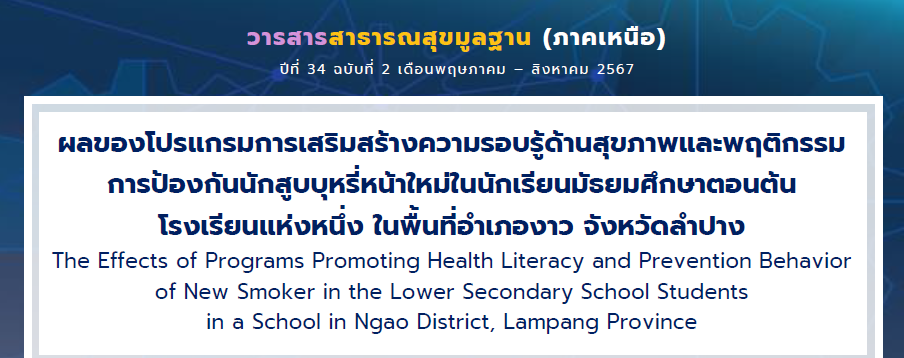The Effects of Programs Promoting Health Literacy and Prevention Behavior of New Smoker in the Lower Secondary School Students in a School in Ngao District, Lampang Province
Keywords:
Program to enhance health literacy, Smoking prevention behavior, New SmokerAbstract
This study used a quasi-experimental research approach, utilizing a pretest-posttest methodology. A research project was conducted to assess the effect of a health literacy and prevention program on new smokers in a lower secondary school in Ngao District, Lampang Province. The study involved two groups, an experimental group and a control group, each consisting of 60 individuals. Both the experimental and control groups received standard instruction from the school. However, the experimental group was provided with a program aimed at improving health literacy and promoting preventative behavior, specifically for new smokers among middle school kids. The program integrates the notion of health literacy. There is an addition of time every Friday from 1:00 p.m. to 3:30 p.m. Comprising of four activities, requiring a duration of four weeks to finish. We conducted a comprehensive analysis of the data using statistical methods including frequency, percentage, mean, standard deviation, paired t-test, and independent t-test.
The findings indicated that the mean scores of the overall health literacy of the experimental group was significantly statistically higher after the implementation of the intervention (p<.05). Meanwhile, their overall prevention behavior in smoking after participation in the program was greater than that before attending it (p<.05).
The recommendation of this study highlights the importance of equipping young leaners with essential daily skills, including access of information skills, cognitive skills, communication skills, self-management skills, decision-making skills, and media literacy skills. All skilled should be applied for their effective health care, and knowledge sharing with others.
References
กองสุขศึกษา กรมสนับสนุนบริการสุขภาพ กระทรวงสาธารณสุข. (2561). การเสริมสร้างและประเมินความรอบรู้ด้านสุขภาพและพฤติกรรมสุขภาพ. นนทบุรี: กองสุขศึกษา กรมสนับสนุนบริการสุขภาพ กระทรวงสาธารณสุข.
กรมสนับสนุนบริการสุขภาพ. (2561). การเสริมสร้างและประเมินความรอบรู้ด้านสุขภาพและพฤติกรรมสุขภาพ. นนทบุรี: กองสุขศึกษา กรมสนับสนุนบริการสุขภาพ.
กรมควบคุมโรคกระทรวงสาธารณสุข. (2560).“พระราชบัญญัติควบคุมผลิตภัณฑ์ยาสูบ พ. ศ. 2560.” https://ddc.moph.go.th/law.php?law=2
กองโรคไม่ติดต่อ กรมควบคุมโรค. (2564). บุหรี่ คืออะไร ประเภทและสารในบุหรี่. เข้าถึงได้จาก http://www.thaincd.com/2016/media-detail.php?id=14004&gid=1-015-009
ขวัญเมือง แก้วดำเกิง. (2561). ความรอบรู้ด้านสุขภาพ เข้าถึง เข้าใจ และการนำไปใช้. กรุงเทพฯ: อมรินทร์.
จีรภัทร รัตนชมภู, และณรงค์ศักดิ์ หนูสอน3 (2563). การป้องกันนักสูบหน้าใหม่ สังคมไทยต้องเปลี่ยนแปลง. วารสารวิทยาลับพยาบาลบรมราชชนนี อุตรดิตถ์, 12(1), 13-27.
ณัฐชยา พลาชีวะและปราโมทย์ ถ่างกระโทก. (2564) ผลของโปรแกรมป้องกันการสูบบุหรี่โดยใช้อินเตอร์เน็ตเป็นฐานสำหรับนักศึกษาในศูนย์การศึกษานอกระบบและการศึกษาตามอัธยาศัย. วารสารพยาบาลสภากาดชาดไทย, ปีที่ 14 ฉ.1 ม.ค.-มิ.ย.64, 257-272
ธนะวัฒน์ รวมสุก, สุรินธร กลัมพากร, ทัศนีย์ รวิวรกุล, ทัศนีย์ อรรถารส, อารยา ทิพย์วงศ์, นภิสรา ธีระเนตร, และจิราภรณ์ อนุชา, (2565). ความสัมพันธ์ระหว่างความรอบรู้ทางสุขภาพกับพฤติกรรมการสูบบุหรี่ ของนักศึกษาสถาบันอุดมศึกษา กรุงเทพมหานคร. วารสารพยาบาลทหารบก, ปีที่ 23 ฉบับที่ 2 พฤษภาคม-สิงหาคม 2565, 357-363
นพรัตน์ รัตนวรากรณ์, ธนพร เบญจพะ และชวนพิศ ตฤนานนท์. (2561), การตรวจสารนิ โคดินในของกลางบุหรี่ไฟฟ้า. http://innovation.dmsc.moph.go.th/InnovationV1.6 ProfileProject.php?ROW_REF=397&PERSON ID=405
ประกิต วาทีสาธกกิจ. (2562). การสูบบุหรี่ของเยาวชน (รายงานการวิจัย). กรุงเทพมหานคร: มูลนิธิรณรงค์เพื่อการไม่สูบบุหรี่.
พัชรินทร์ อัจนากิตติ, ทัศนีย์ รวิวรกุล, สุรินธร กลัมพากร, และนฤมล เอื้อมณีกลู, (2565). ผลของโปรแกรมป้องกันนักสูบหน้าใหม่ ในนักเรียนอาชีวศึกษา. วารสารพยาบาล, 71(1), 10-19, 2565, 10-19
ภาสกร เนตรทิพย์วัลย์, (2564). โปรแกรมสร้างเสริมความรอบรู้ทางสุขภาพเพื่อพัฒนาพฤติกรรมการป้องกันการสูบบุหรี่ในวัยรุ่นตอนต้นโดยประยุกต์การจัดการเรียนรู้แบบปรากฎการณ์เป็นฐาน.(วิทยานิพนธ์ดุษฎีบัณฑิต). กรุงเทพมหานคร: มหาวิทยาลัยศรีนครินทรวิโรฒ
วิกานต์ดา โหม่งมาตย์. (2561). ปัจจัยที่ส่งผลต่อพฤติกรรมการป้องกันการสูบบุหรี่ของนักเรียนชาย ชั้นประถมศึกษาตอนปลาย อำเภอเมือง จังหวัดนครปฐม (วิทยานิพนธ์ปริญญามหาบัณฑิต). นครปฐม: มหาวิทยาลัยศิลปากร
วิลาวัณย์ ประทีปแก้ว, พรเทพ ล้อมพรม, และวัลภา พรหมชัย. (2552). พฤติกรรมการสูบบุรี่ของเยาวชนในจังหวัดนนทบุรี(รายงานผลวิจัย). กรุงเทพฯ: ศูนย์วิจัยและจัดการความรู้เพื่อการควบคุมยาสูบ(ศจย.).
ศูนย์วิจัยและจัดการความรู้เพื่อการควบคุมยาสูบ[ศจย.]. (2562). ก้าวทันวิจัยกับ ศจย. ศูนย์วิจัยและจัดการความรู้เพื่อการควบคุมยาสูบ[ศจย.] ระยะที่ 5 ปีที่ 11 ฉบับที่ 2 พ.ศ.2562
สำนักงานสถิติแห่งชาติ. (2564). การสำรวจพฤติกรรมด้านสุขภาพของประชาการ พ.ศ.2564. สืบค้นจาก http://ncdstrategy.ddc.moph.go.th/home/media/143
สำนักควบคุมการบริโภคยาสูบ กรมควบคุมโรค. (2557). สวรส. ร่วมเครือข่ายสุขภาพผนึกพลังหนุนภาพคำเตือนบนซองบุหรี่ 85 % พร้อมต้านบริษัทบุหรี่ข้ามชาติ ก้าวสู่สังคมไทยปลอดบุหรี่. เข้าถึงได้จาก https://www.hsri.or.th/news/1/501
อนาวิน ภัทรภาคินวรกุล, ปรภัทร คงศรี, และสมหมาย กล้าณรงค์, (2566). ผลของโปรแกรมการสร้างเสริมสุขภาพเพื่อป้องกันนักสูบหน้าใหม่ ในสถาบันอุดมศึกษา จังหวัดแม่ฮ่องสอน. วารสารการแพทย์และสาธารณสุขเขต 4, ปีที่ 13 ฉบับที่ 1 มกราคม-เมษายน 2566, 113-128
Kutner M, Greenberg E, Jin Y, Paulsen C. The health literacy of America's adults: results from the 2003 national assessment of adult literacy (NCES 2006-483).Washington, DC: National Center for Education Statistics; 2006.
Osborn RH, Batterham RW, Elsworth GR, Hawkin M, Buchbinder R. The grounded psychometric development and initial validation of the health literacy questionnaire (HLQ). BMC Public Health 2013; 13:658. https://doi.org/10.1186/1471-2458-13-658
Schillinger D, Grumbach K, Piette J, Wang F, Osmond D, Daher C, et al. Association of health literacy with diabetes outcomes. JAMA 2002:288(4):475-82.
World Health Organization. (2023). Tobacco Control in South-East Asia Region. Retrieved from https://www.who.int/southeastasia/health-topics/tobacco/tobacco-control-in-the-south-east-asia-region

Downloads
Published
How to Cite
Issue
Section
License

This work is licensed under a Creative Commons Attribution-NonCommercial-NoDerivatives 4.0 International License.



